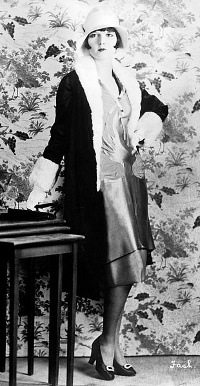The Great Gatsby Contents
Feminist interpretations of The Great Gatsby
Female roles
A feminist approach to the The Great Gatsby might focus not only on the female characters such as Daisy, Jordan and Myrtle, but other minor female characters and a selection of female party guests.
Independent women
 Many of the female characters are seen enjoying the freedoms of the ‘flappers’ in the Jazz Age. Jordan in particular resists social pressure to conform to feminine norms. She plays golf, seems androgynous in her appearance, doesn’t have a ‘home influence’ or a chaperone, drives, drinks alcohol and attends Gatsby’s parties. Catherine, Myrtle’s sister, claims to live a similarly independent life, visiting other countries and sharing her accommodation with a ‘girlfriend’ rather than a husband or family.
Many of the female characters are seen enjoying the freedoms of the ‘flappers’ in the Jazz Age. Jordan in particular resists social pressure to conform to feminine norms. She plays golf, seems androgynous in her appearance, doesn’t have a ‘home influence’ or a chaperone, drives, drinks alcohol and attends Gatsby’s parties. Catherine, Myrtle’s sister, claims to live a similarly independent life, visiting other countries and sharing her accommodation with a ‘girlfriend’ rather than a husband or family.
Dependent women
Daisy and Myrtle are more conventional in that they are married, although they are both prepared to have affairs. Daisy is presented as being extremely seductive in Nick’s description, with special emphasis given to her voice. However, she is finally revealed as false, ultimately corrupt in her carelessness and concern for money. Her bitterness and cynicism is signalled early in the novel as she expresses a devastating critique of women’s position in society with reference to her daughter:
Myrtle’s characterisation is more focussed on her physicality, and she is more quickly undermined as artificial, corrupt and even grotesque. Her death is undignified and stresses the destruction of specifically feminine aspects of her: her left breast is ‘swinging loose’ and her mouth is ‘ripped’. It is possible to argue that Myrtle is punished severely for her sexuality, while Daisy, less overt about her illicit relationship with Gatsby, and a less sensual character altogether, is able to resume her life with Tom once she has abandoned Gatsby.
Degraded femininity
The representation of the other female party guests can be interpreted as more critical, and degrading: some are named, but others are merely ‘Beluga’s girls’ or
Some women suffer indignity at the hands of men:
- you got her dress all wet when you stuck her head in the pool
- the dispute ended in a short struggle, and both wives were lifted, kicking, into the night.
None of them are abused as much as Myrtle, whose nose is broken by Tom and who is locked up by George when he discovers her infidelity.
Other images of women in the novel might include the dreamlike drunken woman on the stretcher, in a scene imagined by Nick as representing his idea of the East. This woman is a casualty, dependent on men to carry her, but utterly powerless as she is incapacitated. She has no identity and ‘no one cares’; a feminist might ask if she is meant to represent all women or a type of woman (the ‘flapper’ type?) or if she represents all of American society in the East.
Patriarchal attitudes
Feminist analysis might also explore:
- The attitudes towards women expressed by any of the characters
- The power relations between men and women
- Ways in which patriarchal values are enforced or resisted by the characters.
The idealisation of Daisy, and the struggle between Tom and Gatsby over her, as if she is a possession or token, would be a clear starting point. The dialogue mostly refers to Daisy in the third person or demands that she reinforce the statements of either male, with the final declaration from Tom: ‘She’s not leaving me!’ Tom is a particularly domineering and powerful male figure, oppressive towards male and female characters alike, and he seems to be almost a caricature of patriarchy, mocked subtly by Daisy and Jordan in Nick’s presence:
Tom’s hypocrisy, as he defends the family while engaging in numerous affairs, doesn’t necessarily undermine his power. However, the ideal of the ‘nuclear family’ (certainly a powerful concept in the 1920s) is undermined by his actions. Throughout the novel, marriage, often seen in feminist criticism as a patriarchal construct, is a failed institution. Infidelity is the norm, with misunderstanding, discord and violence erupting in every relationship (‘I’ve got my wife locked in up there’).
Perhaps most problematic for some feminist readers is Nick’s comment, phrased to assume the reader’s agreement: ‘Dishonesty in a woman is something you never blame deeply.’ Whilst Gatsby idealises women, creating an unachievable image of Daisy, Nick moves towards stereotyping women and, even though his attitude is accepting, this is a negative idea of women which feminist critics might challenge.
Feminist analysis of narrative
The above approaches privilege the female characters within the text, but it is also possible to consider the novel in terms of the ways it is constructed, particularly the non-linear ways in which the narrative proceeds. Where there are layers of narrative voices, several climactic episodes or ambiguity, feminist critics might claim that this is a more ‘feminine’ style of writing (ecriture feminine), despite being written by a man for a mixed audience. The choice of Nick, a male narrator, is also open to feminist analysis. He is to some a very feminine character, despite maintaining his focus on Gatsby’s experience as a subject.
Feminist criticism might also explore the novel in terms of genre: The Great Gatsby is ostensibly a ‘love story’ and uses mostly domestic settings, but it intersects with several other genres, including ‘mystery’ , ‘quest’ and ‘bildungsroman’, and it is as absorbed with cars and wealth, male competition and display, as it is with romance.
Recently Viewed
Scan and go

Scan on your mobile for direct link.